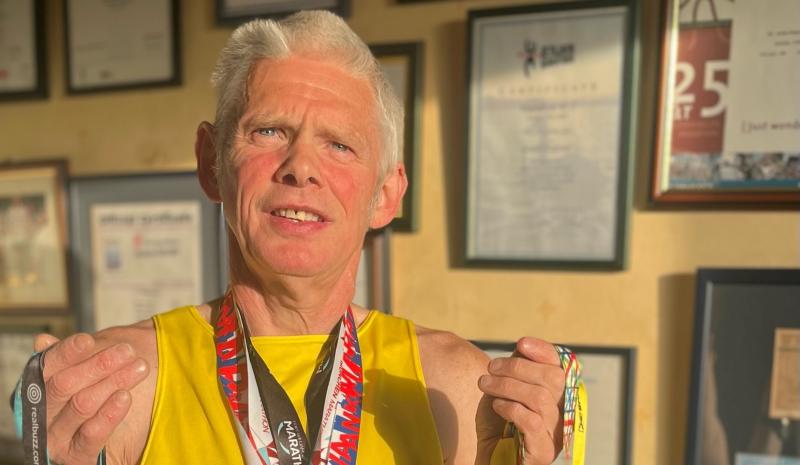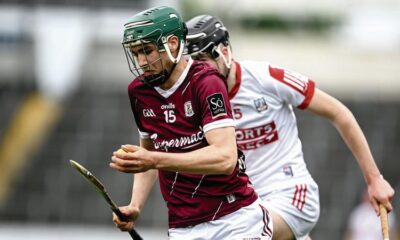Featured
A sense of wonder leads Conor to the priesthood

Lifestyle – Judy Murphy meets newly-ordained Fr Conor McDonough who has made the journey from science to theology
Religion and science aren’t often seen as compatible bedfellows, but according to Galwayman Fr Conor McDonough who has just been ordained into the Dominican Order, they fit very well together.
Fr Conor was a science student at King’s College, Cambridge, studying Physics and Maths, when he decided to embrace religious life and switched to theology. It was a move that made sense for the Salthill-born student, who had been drawn to religion from childhood.
“There’s a great harmony between them,” he feels. “I love science and still do, but I love it with the heart of a believer. A lot of my college friends, especially in physics, were believers – evangelical Christians.”
Physics explores the basic principles of things, he adds. “You can see patterns, so ideally you are at the foundation of things and you can see the beauty at the heart of things.”
Conor grew up in Knocknacarra Road, the middle child in a family of five boys and a girl in a house where faith was very important.
There were inklings of a vocation when he was a child, but “that’s fairly common among Catholic young lads”.
He remembers singing the song Here I Am Lord at the Solemn Novena in the Cathedral when he was eight or nine, thinking he’d “do anything” for God.
But when he became a teenager, life moved in a different direction. Conor had always loved school and was a high achiever who, aged just 17, went to Cambridge to study science after completing his secondary education at St Mary’s College in Galway City.
His chosen subjects were Maths and Physics, but then his direction in life changed again.
“It was at Cambridge that I was taken out of my comfortable Catholic bubble where faith was a given and everyone believed. It wasn’t challenged until I went there,” says the 30-year-old.
In Cambridge, Conor had a “a lot of friends who were atheists” and who called upon him to really question his beliefs.
There was also a Catholic chaplaincy at the university, and “we’d meet, debate, pray loads and socialise loads. It was a great resource for me”.
Having friends who challenged him and who expected Catholics to have a high standard of behaviour helped Conor to discover a “love for living the faith and explaining faith, and for doing it with a community around me”, he recalls.
He realised that the early calling to religious life had never really disappeared and started exploring his options.
He knew he wanted to join an order and having done his research, felt that the Order of Preachers, better known as the Dominicans, was for him as “their message is what I was passionate about”.
That message was “about communicating the faith and the gospel and doing it with a community”, he explains, adding that the Dominicans also place a huge emphasis on continual learning, something that appealed to his academic nature.
Not all religious orders are the same and as Conor explains it, the subtle differences become apparent.
“The Benedictines are about the worship of God and contemplative prayer and the Jesuits are about communicating faith and the gospel, but they are more individualistic than Dominicans.
“Dominicans pray together four or five times a day, we eat together and we never live on our own.”
For more, read this weeks’s Connacht Tribune.
Connacht Tribune
West has lower cancer survival rates than rest

Significant state investment is required to address ‘shocking’ inequalities that leave cancer patients in the West at greater risk of succumbing to the disease.
A meeting of Regional Health Forum West heard that survival rates for breast, lung and colorectal cancers than the national average, and with the most deprived quintile of the population, the West’s residents faced poorer outcomes from a cancer diagnosis.
For breast cancer patients, the five-year survival rate was 80% in the West versus 85% nationally; for lung cancer patients it was 16.7% in the west against a 19.5% national survival rate; and in the West’s colorectal cancer patients, there was a 62.6% survival rate where the national average was 63.1%.
These startling statistics were provided in answer to a question from Ballinasloe-based Cllr Evelyn Parsons (Ind) who said it was yet another reminder that cancer treatment infrastructure in the West was in dire need of improvement.
“The situation is pretty stark. In the Western Regional Health Forum area, we have the highest incidence of deprivation and the highest health inequalities because of that – we have the highest incidences of cancer nationally because of that,” said Cllr Parsons, who is also a general practitioner.
In details provided by CEO of Saolta Health Care Group, which operates Galway’s hospitals, it was stated that a number of factors were impacting on patient outcomes.
Get the full story in this week’s Connacht Tribune, on sale in shops now, or you can download the digital edition from www.connachttribune.ie. You can also download our Connacht Tribune App from Apple’s App Store or get the Android Version from Google Play.
Connacht Tribune
Marathon Man plans to call a halt – but not before he hits 160 races

On the eve of completing his 150th marathon, an odyssey that has taken him across 53 countries, Loughrea’s Marathon Man has announced that he is planning to hang up his running shoes.
But not before Jarlath Fitzgerald completes another ten races, making it 160 marathons on the occasion of his 60th birthday.
“I want to draw the line in 2026. I turn 57 in October and when I reach 60 it’s the finishing line. The longer races are taking it out of me. I did 20 miles there two weeks ago and didn’t feel good. It’s getting harder,” he reveals.
“I’ve arthritis in both hips and there’s wear and tear in the knees.”
We speak as he is about to head out for a run before his shift in Supervalu Loughrea. Despite his physical complaints, he still clocks up 30 miles every second week and generally runs four days a week.
Jarlath receives injections to his left hip to keep the pain at bay while running on the road.
To give his joints a break, during the winter he runs cross country and often does a five-mile trek around Kylebrack Wood.
He is planning on running his 150th marathon in Cork on June 4, where a group of 20 made up of work colleagues, friends and running mates from Loughrea Athletics Club will join him.
Some are doing the 10k, others are doing the half marathon, but all will be there on the finishing line to cheer him on in the phenomenal achievement.
Get the full story in this week’s Connacht Tribune, on sale in shops now, or you can download the digital edition from www.connachttribune.ie. You can also download our Connacht Tribune App from Apple’s App Store or get the Android Version from Google Play.
CITY TRIBUNE
Galway ‘masterplan’ needed to tackle housing and transport crises

From the Galway City Tribune – An impassioned plea for a ‘masterplan’ that would guide Galway City into the future has been made in the Dáil. Galway West TD Catherine Connolly stated this week that there needed to be an all-inclusive approach with “vision and leadership” in order to build a sustainable city.
Deputy Connolly spoke at length at the crisis surrounding traffic and housing in Galway city and said that not all of the blame could be laid at the door of the local authority.
She said that her preference would be the provision of light rail as the main form of public transport, but that this would have to be driven by the government.
“I sat on the local council for 17 years and despaired at all of the solutions going down one road, metaphorically and literally. In 2005 we put Park & Ride into the development plan, but that has not been rolled out. A 2016 transport strategy was outdated at the time and still has not been updated.
“Due to the housing crisis in the city, a task force was set up in 2019. Not a single report or analysis has been published on the cause of the crisis,” added Deputy Connolly.
She then referred to a report from the Land Development Agency (LDA) that identified lands suitable for the provision of housing. But she said that two-thirds of these had significant problems and a large portion was in Merlin Park University Hospital which, she said, would never have housing built on it.
In response, Minister Simon Harris spoke of the continuing job investment in the city and also in higher education, which is his portfolio.
But turning his attention to traffic congestion, he accepted that there were “real issues” when it came to transport, mobility and accessibility around Galway.
“We share the view that we need a Park & Ride facility and I understand there are also Bus Connects plans.
“I also suggest that the City Council reflect on her comments. I am proud to be in a Government that is providing unparalleled levels of investment to local authorities and unparalleled opportunities for local authorities to draw down,” he said.
Then Minister Harris referred to the controversial Galway City Outer Ring Road which he said was “struck down by An Bord Pleanála”, despite a lot of energy having been put into that project.
However, Deputy Connolly picked up on this and pointed out that An Bord Pleanála did not say ‘No’ to the ring road.
“The High Court said ‘No’ to the ring road because An Bord Pleanála acknowledged it failed utterly to consider climate change and our climate change obligations.
“That tells us something about An Bord Pleanála and the management that submitted such a plan.”
In the end, Minister Harris agreed that there needed to be a masterplan for Galway City.
“I suggest it is for the local authority to come up with a vision and then work with the Government to try to fund and implement that.”












